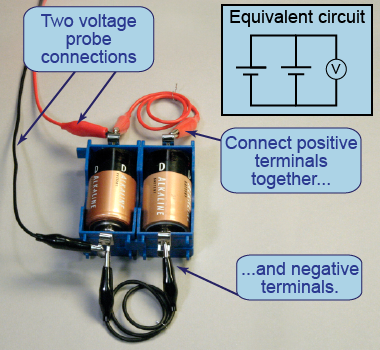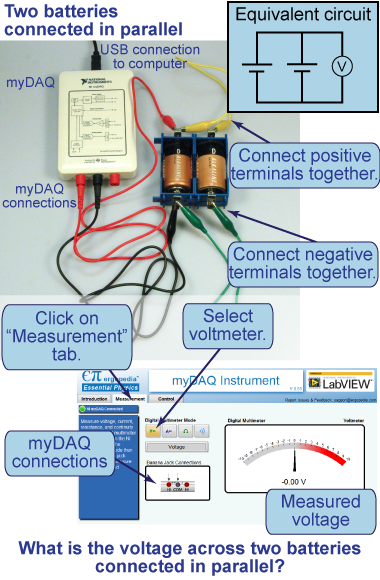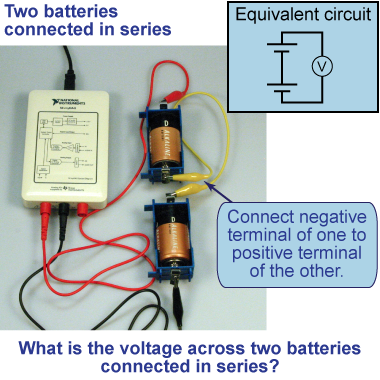| | Essential questions | | How do you connect batteries to increase their total voltage? | |
|
When Alessandro Volta invented the first electric battery, he connected several individual battery cells together to create a more powerful composite battery. How did he connect them? In this investigation you will connect two batteries together and determine how to make the largest combined voltage. 
|
Series and parallel connections
There are two basic ways to connect electrical components together. In a series connection, the two components are connected one after another. In a parallel connection, the components are connected side by side—with the “tops” connected together and the “bottoms” connected together. 
|
Part 1: Connecting the batteries in parallel

- Using voltage probes (such as on a digital multimeter), separately measure the voltage across each of the two batteries.
- Connect the two batteries in parallel: Connect their positive terminals to each other and connect their negative terminals to each other.
- Use voltage probes to measure the voltage across the two batteries connected in parallel.
- Read the voltage rating on the side of each battery. How does the printed voltage compare with what you measured? Why?
- How does the voltage of the two batteries connected in parallel compare with the voltage of either battery measured separately? Why?

How to connect the circuit using a myDAQ
 Alternatively, you can use a myDAQ (in place of the voltage probes or digital multimeter) to measure the voltage across the two batteries when connected in parallel.
Alternatively, you can use a myDAQ (in place of the voltage probes or digital multimeter) to measure the voltage across the two batteries when connected in parallel. - Connect the USB cable between your computer and the myDAQ.
- Launch the instrument application on your computer.
- Click the “Measurement” tab in the application.
- Select the voltmeter using the button.
- Connect the probes to the myDAQ as shown in the illustration (at right).
Now you can proceed to Part 1 above, using the myDAQ in place of the ErgoDAQ.
|
Part 2: Connecting the batteries in series

- Connect the two batteries in series: Connect the negative terminal of one battery to the positive terminal of the other battery.
- Using voltage probes, measure the voltage across the two batteries connected in series.
- How does the voltage of the two batteries connected in series compare with the voltage of either battery measured separately? Why?
- Compare the series and parallel circuits. Which would you use to create the largest voltage?
- Which circuit design would you expect to find in a flashlight or other electrical device?
- Open up the battery compartment of a flashlight and look at any visible wires to see how the circuit is connected. Can you tell whether the batteries are connected in series or parallel?

How to connect the circuit using a myDAQ
 Alternatively, you can use a myDAQ (in place of the voltage probes or digital multimeter) to measure the voltage across the two batteries when connected in series. Follow the myDAQ instructions above in Part 1. Then connect the circuit as shown in the illustration (at right). Now you can proceed to answering the questions above in Part 2.
Alternatively, you can use a myDAQ (in place of the voltage probes or digital multimeter) to measure the voltage across the two batteries when connected in series. Follow the myDAQ instructions above in Part 1. Then connect the circuit as shown in the illustration (at right). Now you can proceed to answering the questions above in Part 2.
| | |
| |
|

